Atlas, 27 Tauri (27 Tau), is a multiple star system located in the constellation Taurus. It is one of the brightest members of the Pleiades (Messier 45), one of the brightest and nearest open clusters to Earth. With an apparent magnitude of 3.63, Atlas is the ninth brightest star in Taurus and the second brightest star in the Pleiades cluster, after Alcyone. It lies at a distance of 431 light years from Earth.
Star system
Atlas has the stellar classification B8 III, indicating a blue-white giant star. The star has a mass 4.74 times that of the Sun and a radius twice solar. With an effective temperature of 13,446 K, it is almost 1,000 times more luminous than the Sun, but most of its energy output is in the invisible ultraviolet part of the spectrum. Like most other named Pleiades, Atlas is a very fast spinner, with a projected rotational velocity of 280 km/s. A disk of material ejected from the star has formed as a result of its rapid rotation.
Atlas may appear as a single star to the unaided eye but is in fact a binary star with components that complete an orbit around each other every 290.984 days. The components, Atlas A and Atlas B, have apparent magnitudes of 3.84 and 5.46. Both stars are slightly variable.
The Catalog of Components of Double and Multiple Stars (CCDM) lists two components with magnitudes of 3.8 and 6.8.
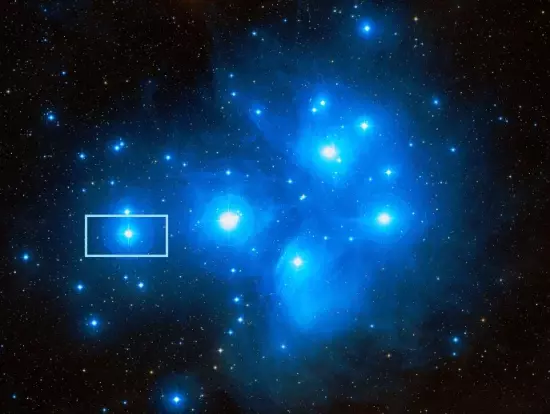
Atlas (27 Tauri), image: Wikisky
Pleiades
The Pleiades cluster, catalogued as Messier 45 by the French astronomer and comet hunter Charles Messier, is one of the brightest and largest open clusters in the sky, stretching across an area of 110 arcminutes. At magnitude 1.6, it is easily visible without binoculars. Observers can usually make out six to eight members, but in exceptionally good conditions, it is possible to see up to 14 stars without binoculars.
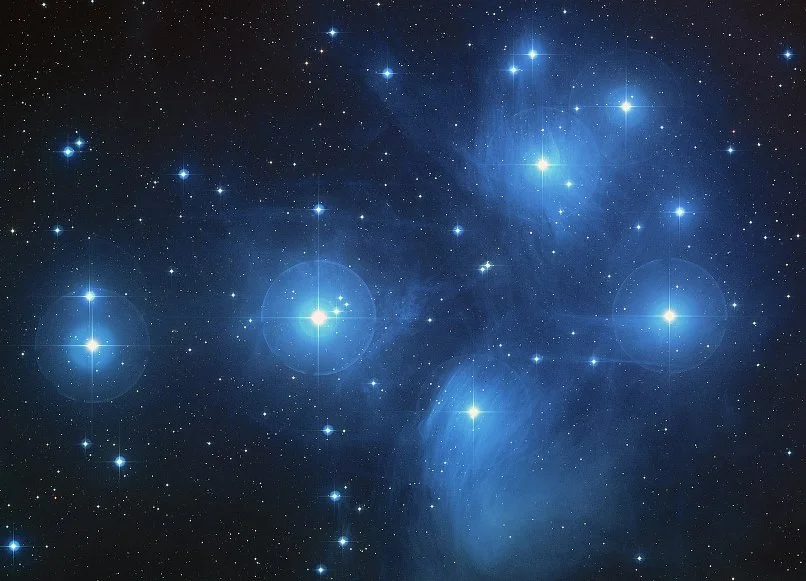
The Pleiades (M45), image: NASA, ESA, AURA/Caltech, Palomar Observatory, credit: D. Soderblom and E. Nelan (STScI), F. Benedict and B. Arthur (U. Texas), and B. Jones (Lick Obs.)
M45 contains over a thousand known members. The brightest ones are hot, luminous stars of the spectral type B, formed within the last 100 million years. The stars are located at an average distance of 444 light years.
Cluster members were formed in the same molecular cloud around the same time and are moving together through space. They will likely keep doing so for another 250 million years, after which the cluster will gradually disperse as a result of interactions with the interstellar neighbourhood.
The nine brightest stars in the cluster are named after the Pleiades, the Seven Sisters in Greek mythology – Alcyone (Eta Tauri), Asterope (21 Tauri), Celaeno (16 Tauri), Electra (17 Tauri), Maia (20 Tauri), Merope (23 Tauri) and Taygeta (19 Tauri) – and their parents, Atlas (27 Tauri) and Pleione (28 Tauri).
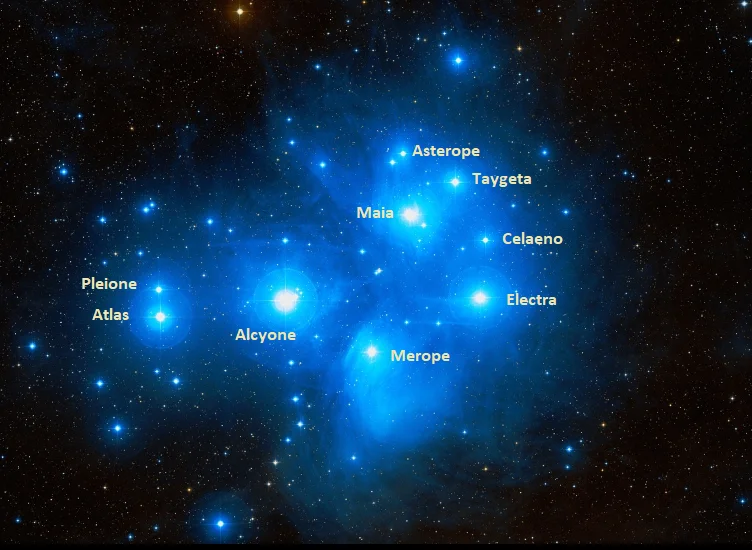
The Pleiades, image: Wikisky
In mythology, the sisters caught the eye of Orion, a giant huntsman. After their father Atlas was condemned to carry the heavens on his shoulders, Orion started to pursue the sisters. Zeus stepped in and first transformed the sisters into doves and then into stars to console their father. The constellation Orion is still said to be pursuing the Pleiades across the sky.
Facts
Atlas is located 3.92 degrees north of the ecliptic, the Sun’s apparent path across the sky.
The Pleiades cluster has been known to cultures around the world since ancient times. The earliest known depiction of its brightest stars was found on the Nebra sky disk, a Bronze Age artifact uncovered in Germany, dating to 1600 BCE. The cluster was mentioned in a number of ancient texts, including the Bible, Homer’s Iliad and Odyssey, Hesiod’s Works and Days, the ancient Egyptian Calendar of Lucky and Unlucky Days, and Kojiki (“An Account of Ancient Matters”), an 8th century Japanese chronicle of myths, legends and oral traditions, where the cluster was mentioned as Mutsuraboshi, “six stars.”
Today, the cluster is known as Subaru in Japan. The automobile company of the same name uses an image of the six brightest stars in its logo.
Italian astronomer Galileo Galilei was the first to observe the cluster in a telescope, and the first to see many cluster members that are too faint to be visible to the unaided eye. Galilei published his notes and a sketch of the cluster in March 1610.
Name
The name Atlas (pronunciation: /ˈætləs/) comes from Greek mythology. Atlas (Greek: Ἄτλας) was one of the Titans who fought and lost a war against the Olympian gods. After the war, he was condemned to carry the heavens on his shoulders. Atlas and the Oceanid nymph Pleione were the parents of the Pleiades and the Hyades.
The name was officially approved by the International Astronomical Union’s (IAU) Working Group on Star Names (WGSN) on August 21, 2016. It formally applies only to the component 27 Tauri Aa1.
The Chinese know Atlas as the Seventh Star of Hairy Head. Hairy Head is an asterism formed by the Pleiades stars Asterope, Atlas, Electra, Maia, Merope, Taygeta, and Alcyone. It is one of the seven mansions of the White Tiger.
Location
The Pleiades cluster is very easy to find because of its exceptional size and brightness. It lies along the imaginary line extended from the stars of Orion’s Belt – Alnitak, Alnilam and Mintaka – past Aldebaran, the brightest star in Taurus, but it can normally be spotted without any help because it appears as a bright bunch of grapes.
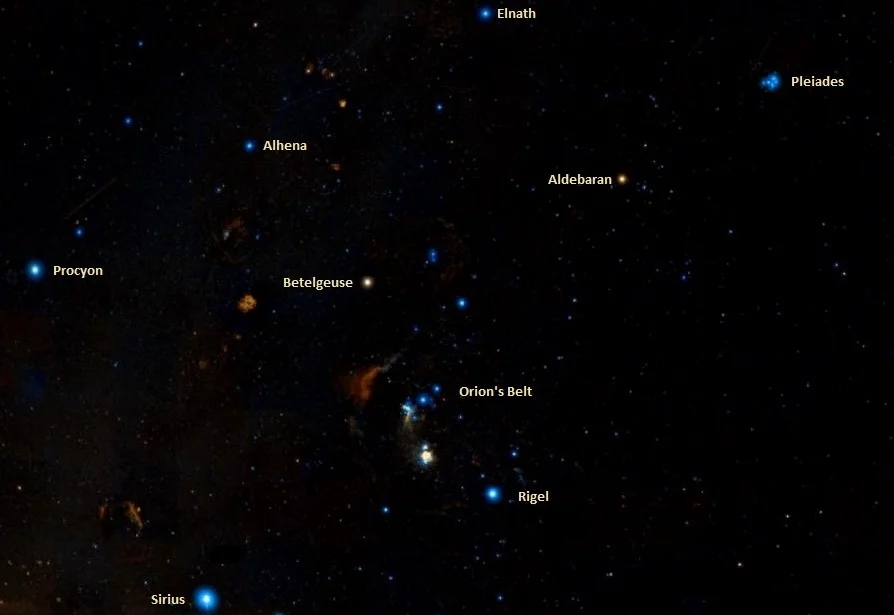
Pleiades location, image: Wikisky
The cluster is prominent in the sky in the months from October to April. It cannot be seen in May and June, when it is too close to the Sun.
Constellation
Atlas is located in the constellation Taurus. Taurus is one of the largest and most prominent northern constellations, occupying an area of 797 square degrees. Known for the orange supergiant Aldebaran, the 14th brightest star in the sky, and the two exceptionally bright open clusters – the Pleiades and the Hyades – Taurus is very easy to identify. The bright Aldebaran, found along the imaginary line extended from Orion’s Belt, marks the Bull’s eye and the Hyades stars outline its head, while Elnath (Beta Tauri) and Tianguan (Zeta Tauri) mark the Bull’s horns.
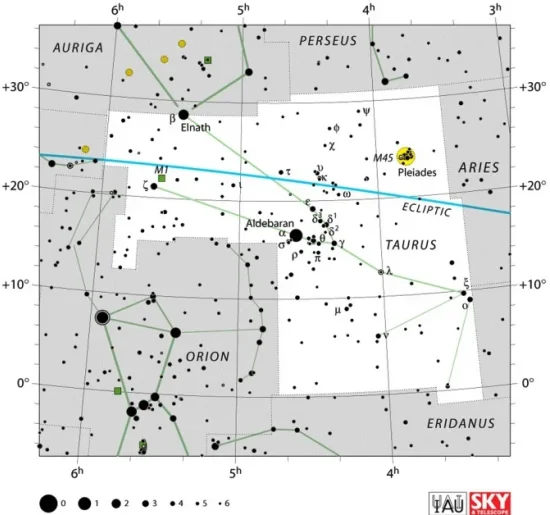
Taurus constellation map by IAU and Sky&Telescope magazine
Taurus contains a number of other interesting deep sky objects. The best known of these are the Crab Nebula (Messier 1), a historic supernova remnant, the planetary nebula NGC 1514 (the Crystal Ball Nebula), the open clusters NGC 1817 and NGC 1647, the merging galaxies NGC 1409 and NGC 1410, and Hind’s Variable Nebula (NGC 1555), a reflection nebula whose brightness varies because it is illuminated by the young variable star T Tauri.
The best time of year to see the stars and deep sky objects in Taurus is during the month of January.
The 10 brightest stars in the constellation are Aldebaran (Alpha Tau, mag. 0.86), Elnath (Beta Tau, mag. 1.65), Alcyone (Eta Tau, mag. 2.87), Tianguan (Zeta Tau, mag. 2.97), Chamukuy (Theta2 Tauri, mag. 3.40), Lambda Tauri (mag. 3.47), Ain (Epsilon Tau, mag. 3.53), Omicron Tauri (mag. 3.61), Atlas (27 Tau, mag. 3.63), and Prima Hyadum (Gamma Tau, mag. 3.654).
Atlas – 27 Tauri
| Spectral class | B8 III |
| Variable type | Suspected |
| U-B colour index | -0.36 |
| B-V colour index | -0.08 |
| Apparent magnitude | 3.63 (3.84 / 5.46) |
| Distance | 431 ± 13 light years (132 ± 4 parsecs) |
| Parallax | 8.53 ± 0.39 mas |
| Radial velocity | 8.5 ± 2 km/s |
| Proper motion | RA: 17.70 mas/yr |
| Dec.: -44.18 mas/yr | |
| Mass (Atlas A, Atlas B) | 4.74 ± 0.25 M☉, 3.42 ± 0.25 M☉ |
| Radius (Atlas A) | 2.0 R☉ |
| Temperature (Atlas A) | 13,446 ± 218 K |
| Rotational velocity (Atlas A) | 280 km/s |
| Surface gravity (Atlas A) | 3.483 ± 0.113 cgs |
| Constellation | Taurus |
| Right ascension | 03h 49m 09.74258s |
| Declination | +24° 03′ 12.3003″ |
| Designations | Atlas, 27 Tauri, 27 Tau, HD 23850, HR 1178, HIP 17847, SAO 76228, FK5 142, BD+23° 557, GC 4586, GCRV 2171, IRAS 03461+2354, PPM 92934, 2MASS J03490974+2403121, TYC 1800-2203-1, Gaia DR2 66526127136550784 |